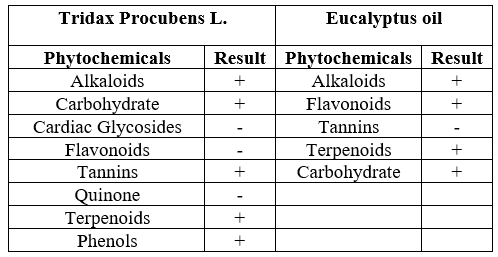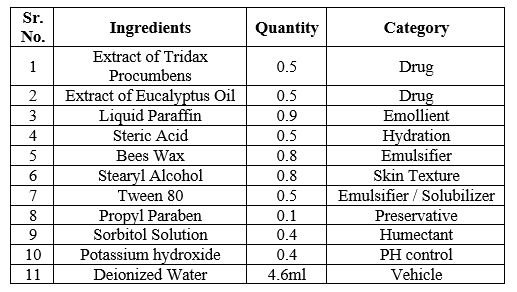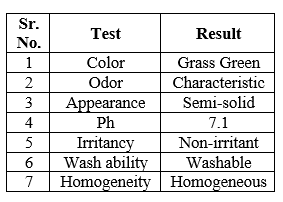Abstract
This study focuses on the development and evaluation of a novel wound healing cream aimed at promoting efficient wound repair and tissue regeneration. The cream formulation includes key ingredients known for their therapeutic properties, including anti-inflammatory, antimicrobial, and skin regeneration-promoting agents. Preliminary results indicate that the wound healing cream exhibits promising properties, including significant antimicrobial activity, enhanced cell migration and proliferation, reduced inflammation, and accelerated wound closure rates compared to control groups. Histological analysis revealed improved collagen deposition and angiogenesis in treated wounds, suggesting enhanced tissue repair and regeneration. Overall, the findings from this study suggest that the developed wound healing cream holds potential for clinical applications in promoting effective wound healing, reducing healing time, and improving overall wound outcomes. Further clinical trials and optimization of the formulation are warranted to validate these initial findings and ensure the cream's safety and efficacy for human use.
Keywords
T. procumbens, Eucalyptus oil, cream, wound healing Activity, Leaf extract
Introduction
Customary medication additionally alluded to as native or society medication envelops the insight went down through ages inside different social orders preceding the appearance of present day clinical practices. It incorporates a scope of customary mending modalities like natural medication, Ayurveda, Siddha, Unani, Iranian, Islamic, and different types of pseudo-clinical information and practices viewed as across the world.The quest for the ideal dressing material go on as wound care experts experience various difficulties in the midst of the developing scene of medication. Considering the development of multi-safe organic entities and a decrease in the viability of more current anti-toxins, wound care experts have returned to old mending strategies, going to customary and elective medication for wound administration. (1)Creams are semi-strong emulsion which is of two kinds Oil in water (O/W) and Water in Oil (W/O). Oil-in-water creams offer more noteworthy solace and corrective allure because of their lower oiliness and simplicity of expulsion with water. Alternately, water-in-oil creams present difficulties in taking care of, yet they are beneficial for consolidating hydrophobic medications, working with their delivery all the more really contrasted with oil-in-water creams. Furthermore, water-in-oil creams give upgraded moisturization by framing a sleek boundary that decreases water misfortune from the layer corneum, the external layer of the skin (2)T. procumbens L. flourishes in tropical and subtropical locales universally, generally found among yearly harvests, along side of the road, in pastures, neglected land, and waste regions.
Botanical description
- Kingdom - Plantae-Plants
- Sub kingdom - Tracheobionta -Vascular plants
- Division - Spermatophyta
- Subdivision -Magnoliophyta-Flowering plants
- Class - Magnoliopsida –
- Order - Asterales
- Family - Asteraceae-Aster family
- Genus - Tridax L.-Tridax
- Species - Tridax procumbens L.-Coat buttons
Phytochemical Screening Of Tridax Procubens Linn (3)
- Each powdered piece of the plants extricate went through phytochemical tests to recognize its constituents. Standard methodology were utilized to survey tannins, saponins, decreasing sugars, alkaloids, terpenoids, flavonoids, cardiovascular glycosides, and anthraquinones, following laid out techniques.
- Alkaloid-
1 ml of concentrate was joined with 1ml of 1% HCl arrangement on a steam shower, trailed by filtration. Then, 1 milliliter of Mayer's reagent was presented. The presence of turbidity demonstrates the presence of alkaloids.
- Sugar A modest quantity of Molisch's reagent was acquainted with 2 ml of the concentrate, trailed by the expansion of 2 ml of concentrated H2SO4. The combination was passed on to represent 2-3 minutes. The presence of a red/dull violet tone at the connection point of the two layers affirmed a positive outcome
- Heart Glycoside
To 5 ml of the concentrate, 2 ml of frigid acidic corrosive were added, trailed by the presentation of a couple of drops of ferric chloride alongside 1 ml of concentrated H2SO4. The presence of a brown/violet/green ring connoted a positive outcome.
After adding a couple of drops of 20% NaOH answer for 2 ml of the concentrate, a yellow variety showed up soon. The variety then blurred to dismal upon the expansion of weaken HCl, showing a positive outcome.
2 ml of the concentrate were treated with a 10% alcoholic ferric chloride arrangement. The presence of a blue/green variety showed a positive outcome.
After adding a couple of drops of concentrated HCl to 2 ml of the concentrate, the development of a yellow hasten showed a positive outcome.
Into 1 ml of chloroform, 2 ml of the concentrate were presented, trailed by the expansion of a couple of drops of concentrated H2SO4. The presence of a ruddy earthy colored hasten showed a positive outcome.
2 ml of the concentrate was treated with fluid 5?rric chloride. The presence of a dark blue/dark variety showed a positive outcome.
- Eucalyptus oil is known for its possible injury recuperating properties because of its antimicrobial and mitigating impacts. It can assist with forestalling contamination and lessen aggravation, advancing quicker mending. Eucalyptus species have been used as customary medicines for different human afflictions since bygone eras.
Botanical description:
- Kindom - Plantae
- Clade- Tracheophytes
- Clade - Angiosperms
- Clade - Eudicots
- Clade - Rosids
- Order - Myrtales
- Family – Myrtaceae
- Subfamily- Myrtoideae
- Tribe- Eucalypteae
- Genus- Eucalyptus
Phytochemical Screening Of Eucalyptus oil:
- Crude extracts (aqueous, methanol, and ethanol) of Eucalyptus oil underwent various phytochemical screenings for alkaloids, carbohydrates, tannins, terpenoids, and flavonoids. Among the above tested phytochemicals, alkaloids, carbohydrates, and terpenoids were present in all extracted samples.
- Alkaloid-
1 ml of extract were mixed with 1 milliliters of 1% HCl solution on a steam bath, and then filtered. Next, 1 milliliter of Mayer’s reagent was added. The presence of turbidity indicated the presence of alkaloids. Confirming the presence of alkaloids, a small amount of olive oil was added to create an emulsion.
When a few drops of 20% NaOH solution were added to 2 ml of the extract, a yellow color quickly emerged within a second. The color subsequently vanished to colorless upon the addition of dilute HCl, suggesting a positive result.
2 ml of the extract underwent treatment with a 10% alcoholic ferric chloride solution. The presence of a blue/green color signified a positive result.
1 milliliter of chloroform received an introduction of 2 milliliters of the extract, followed by the addition of a few drops of concentrated H2SO4. The presence of a reddish-brown precipitate indicated a positive result.
Molisch’s reagent was added to 2 ml of the extract, and then 2 ml of concentrated H2SO4 were added. After allowing the mixture to stand for 2-3 minutes, the appearance of a red/dull violet color at the interface of the two layers confirmed a positive result.
Table 1 : Phytochemical analysis of leaves of plants extract

+ = Present; - = Absent
MATERIAL & METHOD:
Collection of plant material:-
The leaves of Tridex Procumbens and Eucalaptus plant were collected from the local area of Loni village, Ahmednagar District, Maharashtra. It was collected freshly and stored for 4 days for shade drying; furthermore it was coarsely powdered using a mixer grinder. The leaf powder was used for the extraction process.
Methodology:-
- Material used:
All the chemicals and excipient used were of analytical grade provided by college which includes steric acid, Bees wax, Liquid paraffin, Stearyl alcohol, Propyl paraben, Potassium hydroxide, Tween 80, Sorbitol.
- Instrument used:
Soxhlet apparatus, Mixer grinder, Beaker, Stirrer, Funnel, Tripod stand, Incubator, Test-tube, Petri plate, Autoclave, PH meter, heating mental etc.
- Preparation of Extract:
- Extraction of Tridax Procumbens-
Set up the apparatus. Pour a mixture of Ethanol into the round-bottom flask. Place phytochemical-containing sample into the extraction tube, ensuring accuracy. Connect the extraction tube to the flask containing the solvent. Attach the condenser unit to the extraction tube and activate the water flow. Position the Soxhlet apparatus on a heating mental and heat the flask containing the solvent to a temperature range of 50 to 60°C. The solvent evaporates, condenses, and drips into the extraction tube. Allow the process to continue for 24 hours. Stop the process and retrieve the extract from the extraction tube. Place the extract on an electronic water bath for further evaporation. Stop the process once the solvent has evaporated completely, and collect the sample. Combine all the extracts in appropriate proportions for further analysis or use.
- Extraction of Eucalyptus Oil-
Extraction of Eucalyptus oil has been done by using clavenger apparatus. Firstly we chop or crush the leaves of plant & place the material in round bottom flask. Heat the flask gently, allowing the essential oil to vaporize along with water vapor. Let the vapor in the condenser get condense, collecting the oil-water mixture in the flask. Separate the oil from water & Store the extracted Eucalyptus oil. (4)
Formulation of Herbal Cream:
- Formula
Table 2: Formulation ingredients of herbal cream

- Preparation of cream
Liquid Phase
- Steric Acid
- Bees Wax
- Stearyl Alcohol
- Liquid Paraffin
- Propyl Paraben
Water Phase
- Deionized Water
- Sorbitol Solution
- Potassium hydroxide
- Tween 80
- Prepare the liquid phase & water phase by mixing respective ingredients.
- Now mix the drug components in liquid phase at last and add water phase in oil phase.
- Continue the stirring for about 20 – 25 min.
- Pour into container when it is hot.
Evaluation of Herbal Cream: (5) (6)
- Physical Assessment of Home grown Cream-
We reviewed the natural cream for Variety, Scent, and Appearance.
- Measurement of PH-
The pH was resolved using a computerized pH meter. The cathode was submerged in the example ten minutes prior to getting the perusing at surrounding temperature.
Note down the perusing of PH meter.
- Spread capacity
The spreadability of the cream was evaluated utilizing a normalized strategy. This included applying a deliberate measure of cream onto an assigned surface and assessing its capacity to spread equitably and easily. Factors like elusiveness, protection from spreading, and simplicity of utilization were viewed as in deciding the cream's spreadability. (7)
Spreadability was determined utilizing the accompanying recipe:
S = M × L/T
Where, S = Spreadability,
M = Weight in the container (attached to the upper slide),
L = Length moved by the glass slide and
T = Time (in sec.) taken to totally different the slide One another.
- Skin Aggravation
Distinguish a little, subtle region on the skin, like the inward lower arm or behind the ear. Guarantee the region is liberated from any current bothering or Cuts. Apply a modest quantity of the cream onto the test region utilizing a perfect spatula or q-tip. Spread it equitably and permit it to totally dry. Set a clock for the suggested perception time frame, generally 24 to 48 hours. During this time, teach the member not to wash or upset the test region. After the set time, cautiously notice the test region for any indications of aggravation like redness, expanding, tingling, or consuming sensation. Utilize an amplifying glass if necessary. Record the perceptions precisely, noticing the presence or nonappearance of any skin responses.
- Consistency-
Utilize a perfect spatula or spoon to scoop a modest quantity of the cream from the compartment. Attempt to set aside some margin for exact correlations.
- Wash capacity
Assemble the cream test to be tried, clean water, a clock, washcloths or wipes, and a level surface for testing. Apply a limited quantity of the cream onto the skin or surface you wish to test. Guarantee that the application is uniform and covers a characterized region. Permit the cream to dry totally as per the maker's suggestions or for a predetermined period (e.g., 30 minutes). Drying and Review: Subsequent to washing, permit the region to dry normally or wipe it off with a perfect towel. Examine the skin or surface for any buildup or waiting impacts of the cream.
- Stability –
Strength testing of drug items starts during drug disclosure and closes with either the cessation of the compound or the business item. Assessing the soundness of both the medication and its detailing includes leading strength concentrates on as per ICH rules. These examinations, led per ICH rules, involved filling cream into bottles and putting away them in a dampness chamber kept up with at 40±2°C/75±5% relative moistness for quite a long time. Endless supply of the investigations, tests went through examination for actual properties, pH, and consistency.
- Homogenicity-
Mix the cream completely and notice in the event that it keeps a uniform consistency. Assuming there are any clusters or partition happening in the wake of blending, it might demonstrate absence of homogeneity.
Table 3: Physical properties

CONCLUSION:
A formulation of Herbal Skin Cream for wound healing was successfully developed, meeting relevant pharmaceutical standards. The prepared formulations exhibited favorable physicochemical characteristics, with pH levels compatible with skin secretions, and the release was optimal for formulation. This study suggests the feasibility of developing creams containing herbal extracts for use as a skin barrier. Plants possess potent healing properties as they promote natural repair mechanisms. While the wound healing property of the formulated herbal skin cream has yet to be experimentally validated, it will be investigated in future studies.
ACKNOWLEDGEMENT:
We extend our sincere gratitude to Miss. Sneha A. Vikhe (Assistant professor, Pravara Rural College of Pharmacy, Loni) for her invaluable and constructive suggestions throughout the planning and development of this research. We deeply appreciate his generous willingness to dedicate his time to our endeavor. We would also like to express our gratitude to the Head of the Department of QAT, as well as Principal Dr. Sanjay Bhawar and the organizations involved, for facilitating our research by providing necessary resources and support, enabling us to observe daily research operations.
REFERENCES:
- Wound care with traditional,complementary and alternative medicine. AA., Dorai. 2012, Indian J Plast Surg, Vol. 45, pp. 418-24.
- IM, Magdy. 3, 2004, AAPS, Vol. 6, pp. 1-7.
- Plants Used in Cosmetics. Aburjai T, Natsheh FM. 2003, Phytother, Vol. 17, pp. 987-1000.
- Apparatus for the Determination of volatile Oil. Clavenger, J.W. 1928, J. Am. Pharm. Assoc, Vol. 17, pp. 345-349.
- Formulation and evaluation of piperine creama new herbal patients. Vinod KR, Santhosha D, Anbazhagan S. 2, 2011, Int J Pharm Pharm Sci., Vol. 3, pp. 29-33.
- Development and evaluation of herbal wound healing formulations. .Jagtap NS, Khadabadi SS, Farooqui IA, Nalamwar VP, Sawarkar HA. 4, 2009, Int.J. PharmTech Res, Vol. 1, pp. 1104-1108
- Pounikar, Yogesh. 2012, International Journal Of Pharmacy And Pharmaceutical Science, pp. 85-86.


 Abhishek Rajendra Putale *
Abhishek Rajendra Putale *



 10.5281/zenodo.11186336
10.5281/zenodo.11186336